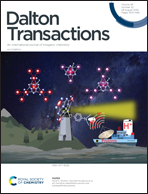Highly selective sensing of Fe3+/Hg2+ and proton conduction using two fluorescent Zn(ii) coordination polymers†
Abstract
A pair of homologues, [Zn(Hssa)(1,4-bib)·H2O]n (1) and [Zn3(ssa)2(1,4-bib)3·4H2O]n (2), were successfully assembled using the same metals and ligands [H3ssa = 5-sulfosalicylic acid; 1,4-bib = 1,4-bis(1H-imidazol-1-yl)benzene] under solvothermal conditions. Polymer 1 is a two-dimensional (2D) sql network and polymer 2 is a three-dimensional (3D) framework. Polymer 2 can be simplified into two topology types: bct and tfc. The two polymers show significant differences in the fluorescence sensing of metal ions and proton conductivity. Their applications in detecting metal ions and proton conductivity were explored. Polymer 1 shows high sensitivity and selectivity for Fe3+, while polymer 2 can detect Hg2+ ions. The limit of detection was 1.66 μM with Fe3+ for 1 and 0.23 μM with Hg2+ for 2 in water. In addition, both 1 and 2 exhibit high water stability and proton conductivity. At 60 °C and 95% relative humidity, their conductivities were 3.45 × 10−5 and 6.26 × 10−6 S cm−1, respectively. A detailed analysis of the Hirshfeld surface and fingerprints was carried out for 1 and 2 to compare the interactions between the molecules, which is essential for analysing the relationship between their structures and material properties.



 Please wait while we load your content...
Please wait while we load your content...